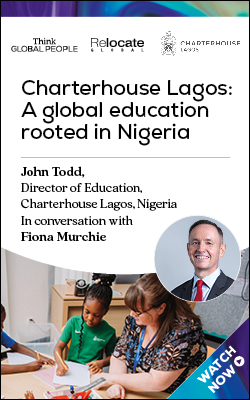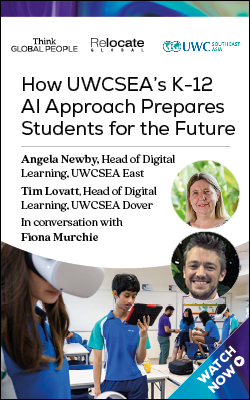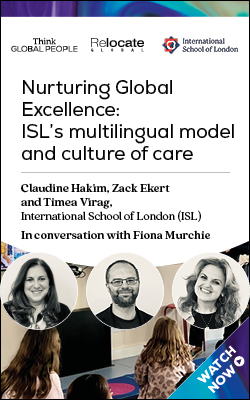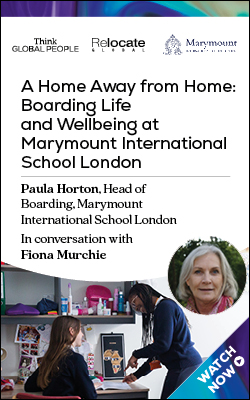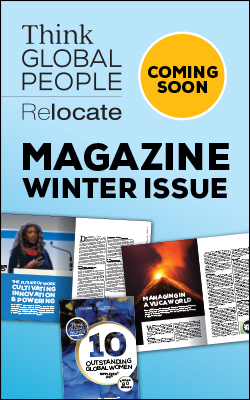Curriculum choice in international schools: a world of options
The international schools’ sector is growing. This means more choice and affordable opportunities to set your child on the path to success with a world-class education. Experts from top schools offer their insights on curriculum choice to help you make the right decisions.

Related reading
- Demystifying international school admissions
- A new virtual world: The Lab School
- International early-learning: a great start
Choosing the right curriculum – a blended approach
School is a significant part of a child’s life. It is critical to supporting self-identity as well as a place for academic and social learning. Schools provide routine, a sense of belonging and set the foundations for careers, university and adult life. For international families, choosing the right school as well as the right curriculum is often a complex decision. Yet it is well-worth looking into all the options to secure the unique benefits international schools offer.Future mobility plans and home language are important factors and why international schools are increasingly offering at least one globally recognised curriculum that is highly transferable between schools, universities and countries.For the Jerudong International School, Brunei, Lycée International De Londres Winston Churchill and American School of The Hague, this is their national curriculum with the additional pathway of the International Baccalaureate Diploma Programme (IBDP) for those who choose it.“It is really important to make sure a curriculum has breadth and choice,” says Tony Piper, Vice Principal and Head of Senior School at the Jerudong International School, Brunei, which offers the British curriculum for children aged 2–18 culminating in GCSE/IGCSE and A-Levels or the IB Diploma.“Kids are entering a world now that isn’t quite as stable as potentially it once was. We are preparing them for the end goal of leaving school so they can link their learning with real-life events around the world.“For me, that runs through the school to Sixth Form, where we’ve got a dual pathway of A-Levels or the IB. A-Levels and the IB programme are accepted the world over and are almost the gold standard of sixth-form study. It means that if a student is moving to a different country, or going to any university in the world, those qualifications are going to be accepted.”Similarly, the American system allows for choice and for students to follow their strengths and interests, as well as be transferability.“It really takes a lot of conversation with families to know what their likely destination is, their hopes for their child and talking to the student to find out what they hope to achieve,” says Kili Lay, Director of Curriculum and Staff Development, American School of The Hague, which offers the American approach to foundational literacy, research skills, mathematical development, science and social studies and an Early Childhood, Elementary, Middle and High School education for children aged 3–18. “The AP [Advanced Placement] could offer some flexibility because it is modular. You can take an AP course in a single subject, or you could take them across multiple areas and put them together in a package.”Highlighting again how greater choice has become the norm in the international schools’ community is the relatively recent establishment and success of schools like the Lycée International De Londres Winston Churchill. It offers a dual-language education for children aged 3-18 with two pathways from Year 7: the Bac Française Bilingue or IB Diploma.“Our specialty is international and French,” explains Head of School, Mireille Rabaté. “The French curriculum, like the IB, is taught all over the world in over 530 schools in a network of AEFE schools. It is highly transferable. I don’t know of a big city in any country in the world that doesn’t have at least one school running the French curriculum.”Language and identity
There has also been a significant shift in recent years in international schools towards promoting cultural awareness and retaining home language for globally mobile families, reflecting global initiatives like UNESCO’s Sustainable Development Goals, which include preserving language diversity. Research has shown that for Third-Culture Kids and Cross-Cultural Kids, maintaining home language is important for self-identity and increases the chances of successful learning all round. At the Jerudong International School, Brunei, this means offering more languages for its local as well as international students. “We’re teaching in English all the time here,” says Tony Piper. “But one of the critical pillars of Brunei culture is the language. We try and make sure that for all our Bruneian students, Malay has a central place with extra options and lessons throughout their time up to GCSE age. From a cultural perspective, it’s really important. Brunei is a small country and very internationally minded. “The other big area for us is our full-boarders from mainland China. Again, they are coming to our school to learn English. What their parents are very keen on is that they don’t forget their Chinese. It’s really important for them if they then pop back into China and the education system there that they continue to make sure their native language is still really strong. That’s something that’s grown in the last three or four years to really make sure students retain their native language.” Developing this sense of inclusion and respect for the home culture of all pupils runs through the American School of the Hague, too. As is fairly typical of a European International School, it has students from many different nationalities speaking lots of different languages. “We definitely take time to celebrate the identities of every member of our class in our community,” says Kili Lay of the American School of The Hague. “Empathy is one of our school’s core values. From the very beginning when students join as three-year-olds, we take time to share stories in different languages, so we do allow for trans-languaging and support the classroom with teachers to help that process. “From the very beginning we start with our host-country language, Dutch. For some, this is their home language and for others it’s a new language. But they are all learning together in one classroom with extension and enrichment. “As they grow, they have some choices in Middle School where they can start to take on the choice of another language. But here we also explore a little bit deeper into identities around language, nationality, race, gender, and we bring in these elements of inclusion. That carries and builds into high school and the older years.”Developing global competencies
Not only are international schools responding to the need for more dual-curriculum options and languages, but they are also giving globally mobile children a vital head-start in developing global mindedness and citizenship. They are investing heavily in this important aspect of an international education.For children away from their home country, being able to properly explore, understand their new environment and be part of a bigger movement for change is an exciting and rare opportunity. “It is exciting and wonderful to get the kids out into the rainforest and for some to actually to go for a week in Borneo and that’s just normal,” says Tony Piper. “We also have our outdoor discovery centre on site, which has been left to be a real rainforest. We use that as an outdoor classroom so students from Reception to Year 13 can use it for coursework and lessons. It is also a really great place where faculties can get together to put their know-how into world problems. “In Brunei, oil is a massive part of the economy. One of the big things the government is doing is looking at the transition from oil. So, we have some green businesses based there. The science, geography department and art departments all work together in this outdoor classroom to give students the experience of success and failure within the school environment. “That’s a massive win for living where we do: to allow kids to get out into the jungle if you like but still within school and to be able to pull in ideas from lots of different subjects and put them into a real-world context.”As well as educating children in these unique settings, international schools are also providing the context for children to have their voices heard and act positively. “There’s definitely an interest in the environment – more than an interest – and we can see that from a very young age,” says Mireille Rabaté, giving an example of what global mindedness means in practice. “Over the years, a culture of student voice, leadership and initiative has taken shape in our school community. I’m very impressed with the way our students express themselves and are active.”“We do have a large number of students across all ages that are really quite passionate about anything related to environmental impact,” adds Kili Lay. “I hear my own kindergartener talking to us at home about choices we make around vegetarian versus meat products, how we are handling our waste, how we’re recycling and the use of plastics in and out of school. “We also have a number of self-initiated student groups starting from 8–9 years old and running all the way up through High School. We’ve had students participating in the protests inspired by what’s happening around them. They are definitely voicing their opinions and getting involved in different ways to make an impact. It’s really neat to see that it’s not just about making a protest, but they are looking at the reaction and impact side of it.”International schools – the future?
“One thing we see as parents and educators as increasingly important is explicitly teaching for this world view, multiple perspectives and transferability,” continues Kili Lay. “But it’s also giving our students the opportunity to see the world as theirs and equipping them with explicitly taught skills that are going to help them solve the complex problems that we face.” “I think international school children transcend national boundaries and think beyond the country,” agrees Tony Piper. “We’ve seen at COP26 in the last few weeks how difficult it is to make a deal with lots of different nations. To have children who celebrate their own national culture, but then also think about the continent and then the globe, I think is really important if we are going to solve these big issues.”Adapting to and overcoming global challenges has also seen international schools lead the way in other areas. During the pandemic, international schools played a critical role in welcoming and supporting families and reaching out to their wider community.International schools were also quickly able to invest heavily and adapt to online learning. What changes do international schools see staying for the future? “I see that definitely the pandemic has changed the way we do everything,” says Mireille Rabaté. “How we live our lives in general as well as there being a place for more virtual interaction. “I do think that there will be more virtual remote-learning. Our teachers are not only trained to deliver the lesson online, but also to create and design lessons that are specifically for online delivery. That little step that makes sure students are present and engaged in the lesson, rather than just being there.” “The holistic education international schools offer is something parents the world over are excited about,” concludes Tony Piper. “Exams are really important and international schools get really great exam results, but it’s everything else around that. The opportunities are out there.”Follow for more content and features from the Great International Education and Schools Fair
Subscribe to Relocate Extra, our monthly newsletter, to get all the latest international assignments and global mobility news.Relocate’s new Global Mobility Toolkit provides free information, practical advice and support for HR, global mobility managers and global teams operating overseas.
 Access hundreds of global services and suppliers in our Online Directory
Access hundreds of global services and suppliers in our Online Directory©2025 Re:locate magazine, published by Profile Locations, Spray Hill, Hastings Road, Lamberhurst, Kent TN3 8JB. All rights reserved. This publication (or any part thereof) may not be reproduced in any form without the prior written permission of Profile Locations. Profile Locations accepts no liability for the accuracy of the contents or any opinions expressed herein.












